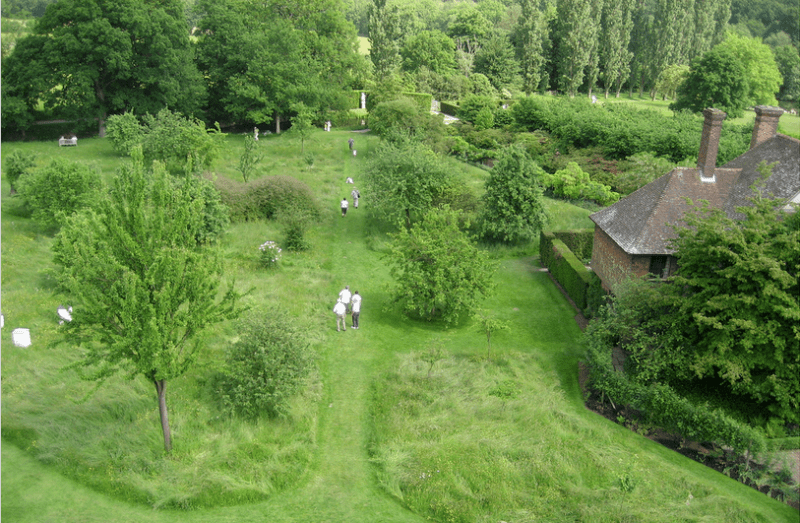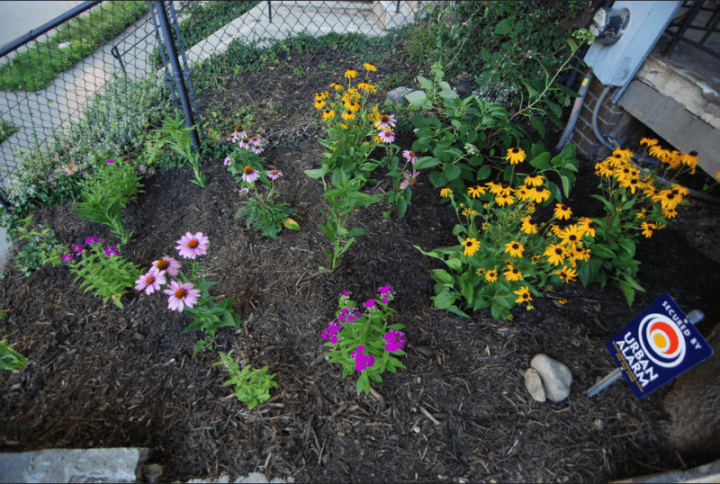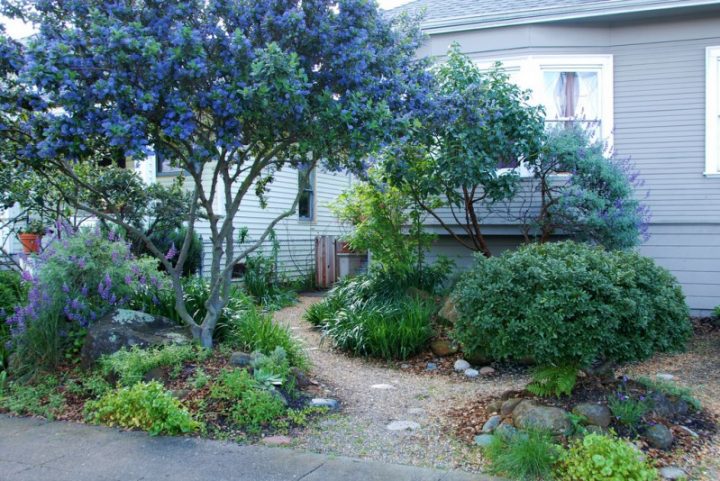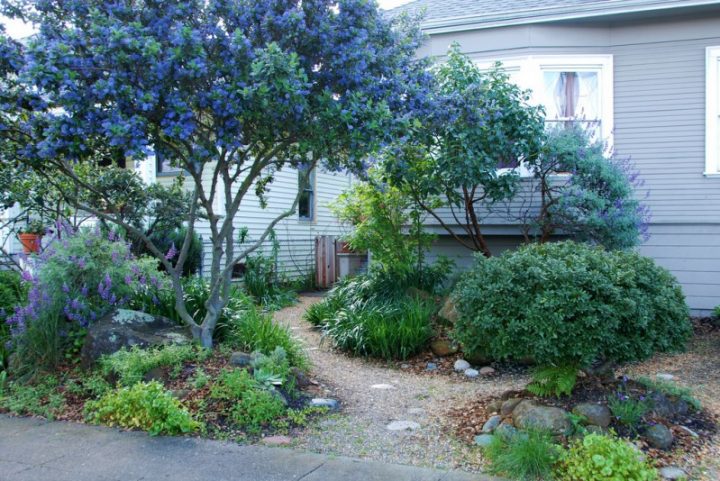Tips to Make a “Messy” Wildlife Garden Look Good
August 26, 2015

One of the top worries we hear from people considering wildlife-friendly landscaping (or even just reducing the size of their manicured lawn) is a concern that it will look too messy. Like it or not, native and wildlife-friendly gardening has a reputation for not being tidy. We think, with a few little tricks, however, you can make even the wildest yard look tame enough to fit in on your block.
Design can use cultural values and traditions for the appearance of landscape to place ecological function in a recognizable context. ~Joan Iverson Nassauer
When it comes to front yards, neighborhood norms dominate people’s preferences. Research has shown that more than anything else, preferences for landscapes are determined by a set of implicit rules about what yards should look like. This is problematic when you want a landscape that not only appeals to your neighbors but also benefits wildlife. The solution? Including visible design cues of human intention in your wildlife-friendly landscape.


Mow the Edges
Meadows can be really beautiful, but in the context of a yard they can look unkempt, or even weedy. Mowing a thin strip along human paths, like streets and sidewalks, is a clear cue to onlookers that the property is actively managed and can transform “untidy” into elegant.
The grounds at the Cornell Lab of Ornithology in Ithaca, New York, are maintained this way, and it results in a lovely space, not only for wildlife–since most of the open areas are left to grow wild–but for visitors and staff who enjoy wandering the maintained pathways.


Space plants wisely. 

Photo by Pete Veilleux, East Bay Wilds.
Space Plants Wisely
Some types of planting decisions can make a space look messier than it really is. One example is planting annuals too far apart. Sometimes this is because plants are expensive and the number needed to fill a space was underestimated during planning. Other times the spacing instructions that came with the plant are misleading.
In order to accurately space plants, first check your USDA planting zone. In zones 2-5, annuals may need to be placed closer together by as much as a third to a half as close as the tags say. The northern growing season for annuals is 5–6 months, not the 8 months that may be assumed on the planting tag. Space plants too far apart, like 12 inches for a salvia, and they won’t fill out and start touching leaves until right around the first fall frost. (Note: Salvias are perennial in some areas, such as in California where there are at least 18 native species).
On the other hand, perennials, like shrubs, are often spaced too closely together. As they grow to their full size they are crowded and look messy. Sometimes, they are pruned to within an inch of their lives when mature to keep from crowding out other landscaping (for more on this visit this great article from Houzz). It is important to take into account their full size when planting, even if it looks bare when they are first planted. Most perennials need to be spaced around 18 inches apart; many larger perennials are best planted 24 or even 30 inches apart.


Massing and Drifting. Clustering plants, rather than just using one of everything, can really create a rhythm in an otherwise wild yard. Notice the drama this planting of Salvia spathacea brings to this space. Also called massing, or drifting, larger clumps of single varieties can attract certain pollinators because of the efficient foraging they offer. Photo by Bri Weldon. 

Think High and Low. Crisp edges and bold patterns in landscaping are another strong cue of management. One way indicate your landscape is well managed is to build in elements that are both high (like large shrubs and trees) and low (like many flowering annuals and grasses). All of one or the other can make a space look flat. Turns out this is good for wildlife as well, since different animals forage, hide, sleep, or nest at different heights. Photo by Pete Veilleux.




Containers, Structures, Other Objects. Non-plant materials can go a long way towards defining spaces in your yard. The massive planter boxes depicted here elevate an otherwise messy collection of plants. You can accomplish this with a variety of materials such as rocks, paths, containers, and walls. Photo by Mechanoid Dolly. 

Mix Woody and Herbaceous Plants. Including both woody and herbaceous plants in a wild garden can help you bring that “high/low” dynamic into a space. Even small woody plants can bring interest and a solidness to a space as herbaceous plants grow and die around the woody ones through the seasons. A solid mix can also help solve some of the spacing issues described above. Photo by Eliot Phillips.


Just Add Paint. This may seem too easy, but we’ve come across landscapers who swear that adding a painted fence or other element to a garden is often interpreted as a sign of investment in a property. Photo by Nana B Agyei. 

Wildlife-Friendly Elements. Nestboxes, bee houses, bird feeders, and birdbaths are another clear visual indicator about your intentions for your property. Sprinkling these throughout your landscape can help people see that your planting choices are for the birds (or the bees). Ready for a nestbox? Check out our NestWatch project for nestbox plans that will work in your area. Photo by Carol Norquist.


Something Linear. Some landscapers, like Pete Veilleux of East Bay Wilds, recommend adding at least one linear element to a wild garden. Examples include a stone wall, clipped hedge, or decorative fence, each of which pulls the eye across a landscape, bringing a clear visual order to a scene. Photo by Pete Veilleux. 

Cover the Foundation. Plantings to obscure house foundations are a nearly ubiquitously desired landscaping element. While the whole foundation should be hidden, make sure the plantings don’t cover any doors or windows. You want the line of sight to these to be open. Photo by Joyce Jenkins.


Err on the Side of Flowers
Skew plants toward those with large and showy flowers. While many trees, shrubs, and herbs have smaller flowers, some natives are known for showy flowers (like eastern purple coneflower (Echinacea purpurea), black-eyed Susan (Rudbeckia fulgida), and Matilija poppies (Romneya coulteri)). Using a disproportionately large number of these kinds of natives (disproportionate to their normal occurrence in a natural landscape) indicates that this is a designed space.


All About Birds is a free resource
Available for everyone,
funded by donors like you













